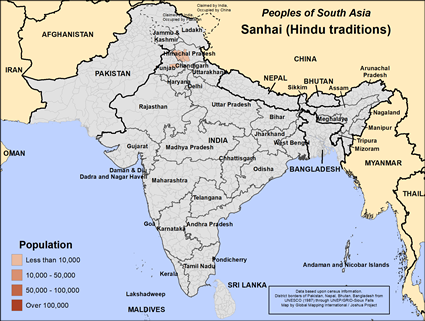Sanhai (Hindu traditions) in India

Send Joshua Project a photo
of this people group. |

Map Source:
People Group data: Omid. Map geography: UNESCO / GMI. Map Design: Joshua Project
|
| People Name: | Sanhai (Hindu traditions) |
| Country: | India |
| 10/40 Window: | Yes |
| Population: | 3,400 |
| World Population: | 3,400 |
| Primary Language: | Hindi |
| Primary Religion: | Hinduism |
| Christian Adherents: | 0.00 % |
| Evangelicals: | 0.00 % |
| Scripture: | Complete Bible |
| Ministry Resources: | Yes |
| Jesus Film: | Yes |
| Audio Recordings: | Yes |
| People Cluster: | South Asia Dalit - other |
| Affinity Bloc: | South Asian Peoples |
| Progress Level: |
|
Introduction / History
The Hindi-speaking Hindu Sanhai people live primarily in the states of Punjab and Himachal Pradesh, India. Historically, they have been involved in agriculture and small-scale trade, with their livelihoods closely tied to the land. Over generations, the Sanhai have adapted to changing economic conditions, with many continuing to farm while others have diversified into various trades and occupations. Their communities are spread across both rural and semi-urban areas.
What Are Their Lives Like?
The Sanhai people lead agricultural lives, cultivating crops such as wheat, rice and sugarcane. Farming forms the backbone of their economy, with entire families working together to manage their fields. In addition to agriculture, some Sanhai families engage in small businesses or labor in nearby towns to supplement their income. Those living in Himachal Pradesh also practice horticulture, growing apples and other fruits.
Village life is central to the Sanhai community, with extended families living in close proximity. Their homes are constructed from locally sourced materials such as brick, stone and mud. Life revolves around farming, family responsibilities and religious observances. While younger generations increasingly pursue education and employment opportunities in urban areas, most remain closely connected to their agricultural roots.
What Are Their Beliefs?
The Sanhai people practice Hinduism, worshiping deities such as Vishnu, Shiva and Durga. Religious festivals, including Diwali, Holi and Makar Sankranti, hold great significance in the community, with families coming together to celebrate and offer prayers for prosperity and protection.
Temples and shrines play a central role in the spiritual life of the Sanhai people, with rituals and ceremonies often reflecting the agricultural calendar. Prayers for a good harvest, timely rains and the health of livestock are common in their religious practices. The community regularly gathers for worship and religious events, reinforcing their sense of identity and faith.
What Are Their Needs?
The Sanhai people face challenges related to education, healthcare and economic development. Many families still rely on traditional farming methods, which makes them vulnerable to environmental changes such as droughts or erratic rainfall. Access to modern agricultural tools, improved irrigation systems and sustainable farming practices would help increase productivity and enhance their livelihoods.
Education is another key need in Sanhai communities, especially in rural areas where access to quality schools is limited. Expanding educational opportunities would provide younger generations with the chance to explore careers beyond agriculture and improve their economic prospects.
Healthcare services are often inadequate, with many families traveling long distances to access basic medical care. Improving healthcare infrastructure and making services more accessible would significantly enhance the well-being of the Sanhai people.
Prayer Points
Pray for their educational and medical needs to be met.
Pray for families of believers loving and serving others to grow reproducing churches.
Pray for grace and truth expanding into the entire Sanhai society as all believers learn to love others.
Pray that churches and believers will bless their entire people group in such a way that God's love will change the Sanhai people like yeast changes dough.